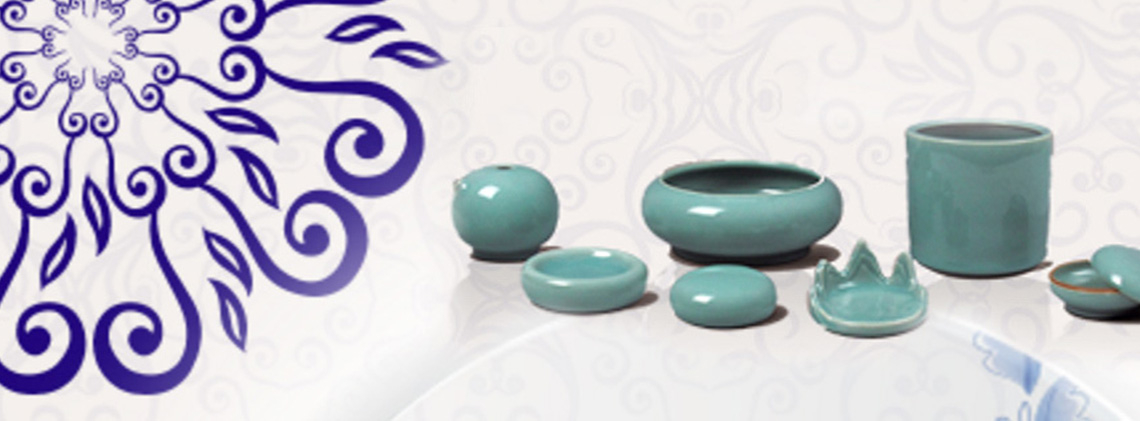
Chinese Ceramics
Splendid
Chi Culture
Topic
Chinese Ceramics
One indicator that a civilization has moved into the Neolithic age is the appearance of pottery vessels. Ceramics were the earliest “new material” mastered by humans; it is hard, durable, and easy to fire. The material used for making pottery generally draws on local resources, which, depending on the area of production, might affect their appearance. For example, some areas may produce terracotta, while other may produce gray, black, or white pottery. In addition to the color that appeared naturally from the raw materials, the craftsmen in some places even painted theirs. As civilization progressed, so did the applications for which ceramics were used.
During the Western Zhou (ca. 1100–771 BCE) period, such items as water pipes, and various roofing materials (e.g., pantiles, semi-circular and eaves tiles) were used in constructing large-scale palaces. This was an important development in the history of Chinese architecture, for in many ceramic tiles more commonly replaced thatched roofs. During the Eastern Zhou period (770–476 BCE), the evil practice of burying people and animals alive to accompany the deceased became less frequent as pottery figurines and objects took their place.
Throughout the long history of ceramics, Chinese potters created hundreds of types of painted pottery. Among these are the world famous Tang dynasty (618–907) “three-color” wares whose name has become a general term for the dynasty’s lead-glazed pottery. These three-color pieces included both items for daily use as well as funereal objects that were buried in tombs. They were largely produced during the middle of Emperor Gaozong’s reign (r. 649–683). During the Kaiyuan era (713–741) of Emperor Xuanzong, ceramic art reached a peak—the craftsmanship was superb, the shapes unique and the glazes were deep and rich.
The development of porcelain proceeded from ceramic making. The main difference between porcelain and pottery is that the former is made from porcelain clay, also known as kaolin, which has much higher amounts of alumina oxide and silica oxide than ceramic clay. Furthermore, porcelain has a lower water absorption rate than ceramics, and the glaze adheres more firmly to the clay body. Even though ceramics were invented independently by the world’s four ancient civilizations, they appeared in China 1,500 years earlier than anywhere else.
An adage goes that one finds “celadon in the south and white porcelain in the north”; this phrase is commonly used to demonstrate the special features of the porcelain industry during the Tang dynasty. Kilns in the south mainly produced celadon, while kilns in the north primarily produced white porcelain.
The Song dynasty (960–1279) is known as an age when “kilns were like trees in a forest.” It was during this period that porcelain developed further and the industry prospered. There are five famous kilns of the Song: Ru, Guan, Ge, Jun, and Ding. The most esteemed of these is celadon ware from the Ru kiln in the north. The glaze sets it apart; it is different from all the other celadon wares. Ru wares became rare in the late Northern Song and early Southern Song period—little survives today; only fewer than a hundred pieces have been collected and are on display at the Palace Museum in Beijing.
Among all the various types of Chinese porcelain, the clean and elegant blue-and-white porcelains enjoy a high reputation around the world and are seen as the representative porcelain of China. Blue-and-white porcelain was produced in large quantities in the Yuan dynasty (1271–1368); later, during the Ming (1368–1644) and the Qing (1644–1911) dynasties it became a mainstream product.
Blue-and-white porcelain is produced by first painting various designs on the clay body using metallic cobalt pigment; glaze is then applied over the body. This glaze is quite adhesive and does not blur the designs. Next, the piece is fired in a 1300°C kiln with a reduction atmosphere. When the firing is complete, the underglaze pigment will appear blue. The bright blue against a white background exudes a sense of simplicity and elegance, as well as evoking traditional landscape painting.
Based on the inheritance of traditional skills and the advances in firing and glaze coloring, modern potters have taken their manufacturing techniques to a new level.




